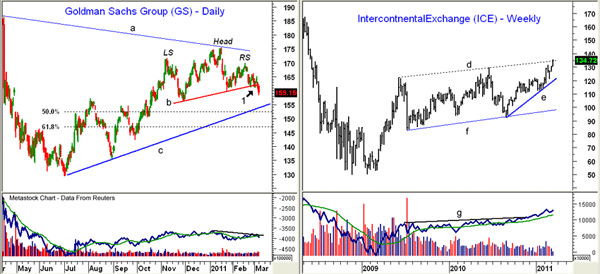With Goldman Sachs lagging and ICE rising on the back of the NYSE merger talks, more experienced investors can profit with carefully planned and executed pairs trade.
Those investing in sector ETFs are sometimes disappointed when a few of the individual companies in the sector double but the ETF moves up just 20%-30%. Of course, what they often do not think about is that some other members of the sector may be down 5%-10%, and if they were unfortunate and picked one of these stocks, they would likely be even more frustrated. This is the beauty of a sector ETF because it can provide broader diversification within a sector.
As I have discussed in past articles, I also use relative performance, or RS analysis, to try to identify the strongest and weakest stocks in a given sector. When the market is in a corrective, or consolidation phase, a pairs trade is often advisable. This is where you sell a weak stock in a sector while simultaneously buying one that is stronger. Currently, this looks like a perfect strategy for Goldman Sachs Group (GS) and IntercontinentalExchange (ICE).
Chart Analysis: Goldman Sachs Group (GS) traded as high as $193.60 in October 2009 and dropped below $130 last summer. The stock, like most of the diversified financial sector, has underperformed the overall market over the past six months.
- The daily chart appears to have completed a head-and-shoulders (H&S) top formation as the major downtrend, line a, was tested on the recent rally. The key neckline support (line b) was broken last week at point 1
- The next support is in the $152.50-$154 area, which corresponds to the uptrend, line c, and the 50% retracement support level
- The downside target from the H&S top is in the $148 area, which corresponds nicely with the 61.8% retracement support at $147
- There is first resistance at $163.50-$165 with more important resistance at the right shoulder in the $170 area. A move back above this level would turn the chart around
- The weekly on-balance volume (OBV - not shown) was unimpressive on the recent rally and the daily OBV has dropped below its weighted moving average (WMA)
IntercontinentalExchange (ICE) as been a stock in play ever since the merger announcement regarding the NYSE hit the tape. ICE is now trying to close above the major weekly trend line resistance, line d, at $134.20.
- The 61.8% retracement resistance from the December 2007 highs at $194.92 is now at $140 with chart resistance from 2008 at $163-$166
- A completion of the trading range, lines d and f, has targets in the $170 area
- There is initial support now at $126-$130 with the near-term uptrend (line e) in the $121 area. Major support is at $115
- The weekly OBV moved through resistance, line g, in December, and the OBV has been leading prices higher. The daily OBV (not shown) has also turned up very sharply, which is quite positive
What It Means: Though the stock market may be ready to consolidate its recent gains, the relative performance, or RS analysis (not shown) indicates that GS will be weaker that the S&P 500 while ICE should be stronger than the overall market.
How to Profit: Given that ICE is just breaking out to the upside, new outright long positions have an uncomfortably high level of risk since the best place for a stop would be under $120. However, given the very weak chart of GS, a pairs strategy looks appropriate for those who are comfortable selling stocks short.
The strategy works as follows: For every 1.2 shares of ICE that are purchased, one share of GS should be simultaneously sold short. For example, if you bought 120 shares of ICE, then you would sell short 100 shares of GS at the same time. I would close out this position if GS closes above $170 or if it declines below $149.20. This is clearly a recommendation intended only for experienced traders and/or investors.






















